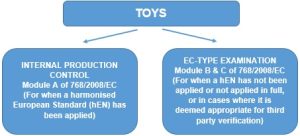Toys that are being sold in Europe are required to be CE Marked under the Safety of Toys Directive. The Equivalent UK legislation is the Safety of Toys Regulations 2011.
Where a product (or material) is intended for use in play by children, of less than 14 years of age, it will be required to be CE marked before that product can be placed on the market in the UK or Europe. Toys for the European market are covered by the Safety of Toy Directive (2009/48/EC) and focuses on the safety aspects of those toys, ensuring that children will not be exposed to any harm.
The scope of the Directive (item intended for use in play by a child of less than 14) can cover a very wide range of products, however it is important to note that not everything that you will find in a toy shop is actually covered by the Safety of Toys Directives.
The term ‘for use in play’ can also create confusion when deciding if a product is a toy or not, particularly when considering virtually all items can have a ‘play value.’ The European guidance notes makes it clear; for a product to be considered a toy, the play value must have been intended to be introduced by the manufacturer, however the manufacturer must also consider the reasonable expected use of the product too. A label stating that the product is not a toy can be used to help the manufacturer state their intent, however they must be able to support this claim.
The Directive sets out a list of products that are not considered to be toys; some* of these products are:
The Safety of Toys Directive sets out two routes to conformity at the choice of the manufacturer. These options are set out below:

Internal Production Control Summary:
This route is entirely a self-declaration route, although they may employee a third party to complete some of the tasks. The manufacturer must apply a harmonised European Standard (hEN), and undertake the tasks set out in Module A of 768/2008/EC (which are summarised below):
Document a conformity assessment
Compile technical documentation
Ensure the manufacturing process maintains a constant level of conformity
Affix the CE mark and other conformity information
Complete a Declaration of Conformity
EC-Type Examination Summary:
This route requires the manufacturer to appoint a third party (known as a Notified Body) to enable them to CE mark their toy. The tasks are similar to those that are set out in the Internal Production Control route, however amongst other items, the technical documentation will need to be reviewed by the Notified Body and the product assessment will also be undertaken by the Notified Body. When the Notified Body finds the product in conformity, they shall issue an EC-Type Examination Certificate, enabling the manufacturer to complete their own Declaration of Conformity.
The CE Marking Association assists manufacturers, importers and distributors of toys on a regular basis and we have a range of services to meet your needs. Here are some of the services on offer:
For more support on CE Marking under the Safety of Toys Directive, or to find out how we can help you, please contact us as below: